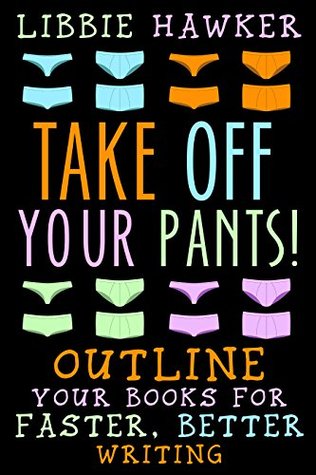 Despite frequent recommendations, I put off reading Libbie Hawker’s Take Off Your Pants for far too long. I’d somehow gotten it into my head that the book was about writing an outline, which sounded like the driest topic imaginable. Imagine my surprise when I glanced over the first page and discovered that Hawker was instead presenting a concise, well-thought-out tactic for crafting a riveting, tightly written novel. (Okay, yes, and she also mentions drafting outlines near the end.)
Despite frequent recommendations, I put off reading Libbie Hawker’s Take Off Your Pants for far too long. I’d somehow gotten it into my head that the book was about writing an outline, which sounded like the driest topic imaginable. Imagine my surprise when I glanced over the first page and discovered that Hawker was instead presenting a concise, well-thought-out tactic for crafting a riveting, tightly written novel. (Okay, yes, and she also mentions drafting outlines near the end.)
You’ll really want to read the book yourself since it costs only three bucks and can be consumed in about an hour and a half. But the gist is simple: the best stories are based on the protagonists’s greatest flaw. The identity of the antagonist and the type of both internal and external conflicts all stem directly from that flaw, and the most satisfying conclusion results when the hero overcomes that flaw.
I’m about halfway through the first draft of my current work in progress, and I thought I’d plotted the story out pretty well. But as I read Hawker’s tips, I realized that a weak chapter a third of the way through was missing an important element of her suggested structure and her book also helped me fill in a gap late in the plot that was giving me fits.
If you give the book a try and want to plot your next (or current) novel using Hawker’s techniques, I drafted a cheat sheet based on her book. The file I’ve linked to probably won’t make much sense if you haven’t already taken off your pants, but hopefully it’ll be a handy addendum once you’ve done the required reading.
What’s up next? Save the Cat was one of the original plotting books that got me off to a good start, and I think the next one on my recommended reading list is The Hero With a Thousand Faces. I’d be curious to hear if you’ve enjoyed other books on story structure (or if you think any kind of canned story outline is heresy) in the comments. Or perhaps you’d like to share your own experience with biting the bullet and leaving behind your pantser ways.

Lots of good advice for writers.
LikeLiked by 1 person
Looks great, I’m dashing over to Amazon . . . . . .once again. 🙂
LikeLike
I’m a plotter, not a panster. Idea, character development, synopsis, and loose outline; that’s how I approach each novel I write. The process helps keep my character-driven stories on track. Any surprises I encounter along the way grow naturally out of the plot. That’s where planning comes in handy for me. My subconscious works quietly in the background, helping me scheme….
Thanks for sharing, Aimee. The title alone makes me want to read the book!
LikeLike
I’m more of a plotter too. Actually, I often write the blurb first to help me sum up the real gist of the story before I start. But this book took my plotting to a different level, helping me gain a coherence I’d lacked before. Definitely worth a read!
LikeLike
Thanks for sharing this one with us, Aimee. Sorry I’m behind on commenting on the latest posts. Still playing catch up from the holidays and some other Real Life issues. While I’m a dedicated Plantster, combining a bit of Plotting with a lot of Pantsing, I’m always learning new things. This sounds pretty interesting, and I’m heading over to pick up a copy right now. Might even read it today, before continuing work on Harbinger. I may pick up some pointers I can still use with this one. 🙂
LikeLike
By the way, I’m in favor of anything that helps a writer tell the story they want to tell. Whatever works. And a good way to know what works for you is to learn more about how others do things. You can then pick and choose your own path, using what feels right to you. Thanks for the Cheat Sheet, and the other links you’ve provided. I’m checking those out, as well.
LikeLike